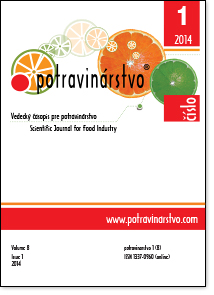Chemical composition of fruits of a feijoa (F. sellowiana) in the conditions of subtropics of Russia
DOI:
https://doi.org/10.5219/358Keywords:
feijoa, form, vitamin, sugar, catalase, pigment, sugar-acid coefficientAbstract
The feijoa is culture quite widespread on the Black Sea coast of Russia. Difficulties are connected with absence in Russia of grades. All gardens have only the mix of grades, which is grown up from seeds. At institute are going of work on creation of productive varieties, with good quality parameters. Data on chemical and biochemical composition of fruits of high-yielding forms of a feijoa are provided in article. After carried-out selection work we selected a large number of perspective forms of a feijoa (more than 50). However not all of them was repeated by the results on productivity and were excluded from works on further studying. For today after rejection there were no more than two tens perspective forms. They differ from each other on productivity, terms of maturing and quality of fruits. On efficiency the D-1 forms (Dagomys), 0-01 (Country) and 10-22 are allocated - productivity of fruits (on the average in 7 years) made respectively 33.3, 20.1 and 12.4 kg from a bush. The plants are sorted out according to the productivity, ripening terms and fruit quality. It is defined that early ripe grades are characterized by higher activity of oxidizing enzymes (263.1 mL.O2.g-1). In a zone of damp subtropics the grades containing increased quantity of carotinoids are steadier (0.31 mg.g-1). The contents in fruits of a feijoa of such substances, as vitamin P, Р-active and pectin substances, ascorbic acid, macro and microelements are revealed. Fruits of a feijoa are differed the increased accumulation of sugars, at some forms the content of sucrose prevails over amount of monosaccharide. High accumulation of vitamin C (41.89 - 78.68 mg.dL-1) is noted. But we don't confirm the high content of iodine in fruits. Fruits of a feijoa can be considered as potential raw materials for production of canned products with a functional purpose.
Downloads
Metrics
References
Golodriga, P. J. et al., 2002. Diagnostics of biological signs and development of objective indicators for an assessment at selection of seedlings of grapes. Wine growing and winemaking. VNIIV and V "Magarach", t. 16. p. 191-204.
Gunar, I. I., 1972. The workshop on physiology of plants. Moscow: Colos. 168 p.
Gutiyev, G. Т., Mosijash, А. С. 1977. The climate and frost resistance of subtropical plants. L.: Gidrometeoisdat. 100 p.
Chirkova, T. V. 2002. Physiological bases of stability of plants. St-Pb.: St. Petersburg univers. publishing house, 244 p.
Koval, I. I., Pritula, Z. V., Komurdzieva, M. А. 1984. The biochemical characteristic of perspective forms of a feijoa in subtropics of Krasnodar region. Subtropical groups. no. 2., p. 25-26.
Melkadze, R. G. 2007 Accumulation of iodine in fruits of a feijoa (Feijoa sellowiana Berg) in the conditions of subtropics of Georgia. Kutaisi scienc. center of Georgia: Mater. of confer. Kutaisi. p. 188-191.
Omarov, М. D., Prichko, Т. G., Trojanova, Т. L. 2003. Feijoa. Food industry. no. 10. p. 81.
Pochinok, X. N. 1976. Method of the biochemical analysis of plants. Kiev: Naucova dumka. 336 p.
Sergeyev, L. V. 1934. Iodine in feijoa fruits. Works on applied botany, genetics and selection. vol. XXV, no. 1. Leningrad, p. 20.
Shlyk, A. A. 1971. Definition of a chlorophyll and carotinoids in extracts of green leaves. Biochemical methods in physiology of plants. Moskow : Nauka. p. 154-171.
Voronzov, V. E., Areshkina, L. J. 1950. Feijoa and its fruits. Bulletins VNIIChSK. no 3., p. 85-91.
Voznesensriy, V. L., Gorbacheva, G. I., Shtanco, T. P. at al., 1962. Technique of definition of sugars on decolouration of liquid of Felinga. Physiology of plants. vol. 9, no. 2, p. 255-256.
Downloads
Published
How to Cite
Issue
Section
License
This license permits non-commercial re-use, distribution, and reproduction in any medium, provided the original work is properly cited, and is not altered, transformed, or built upon in any way.






























